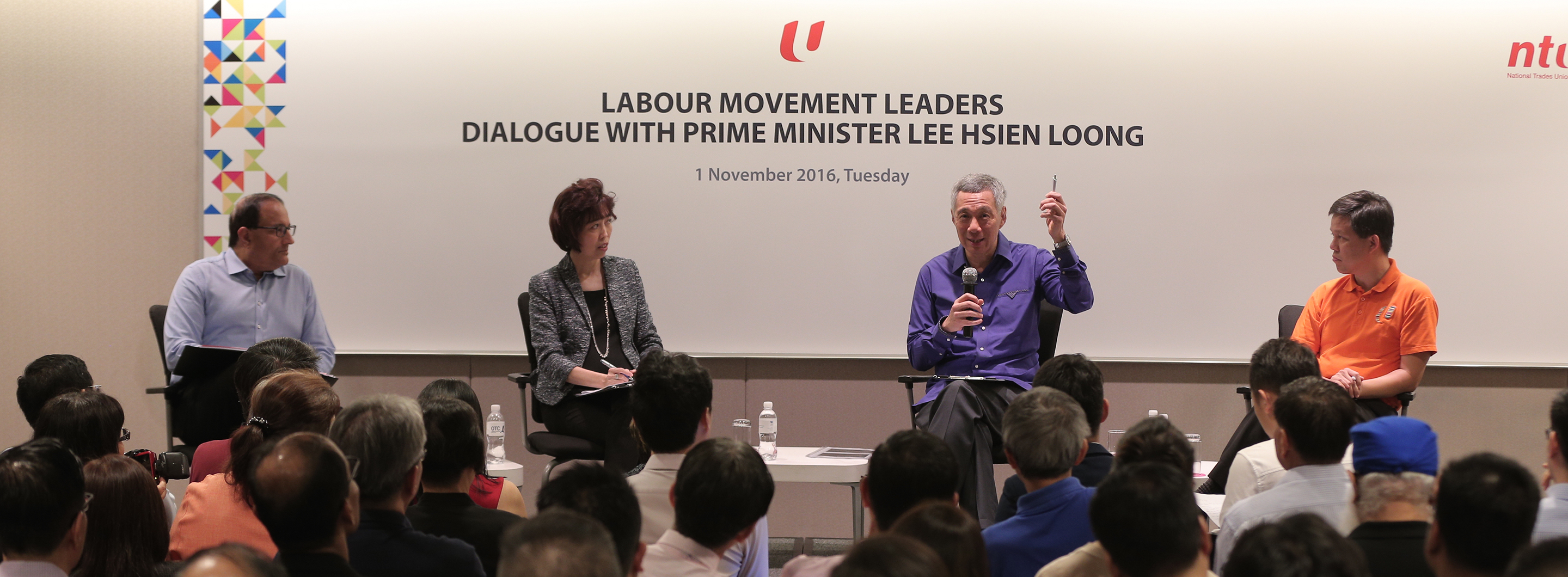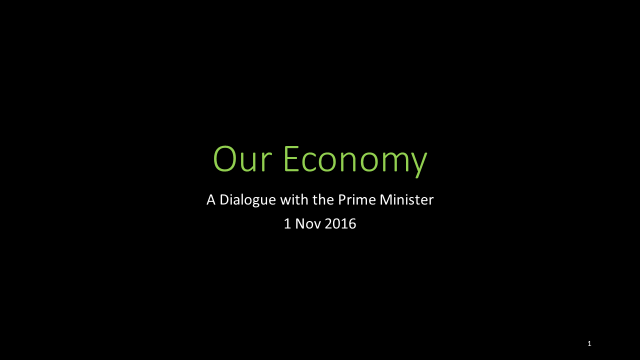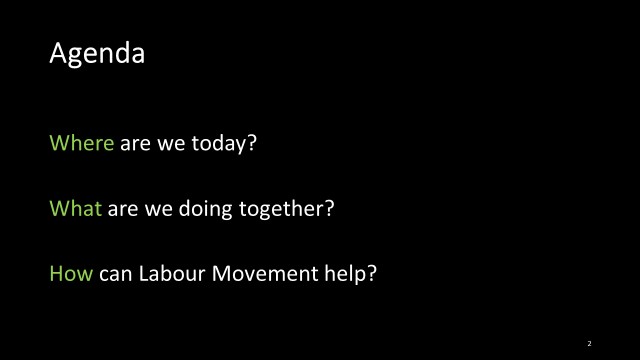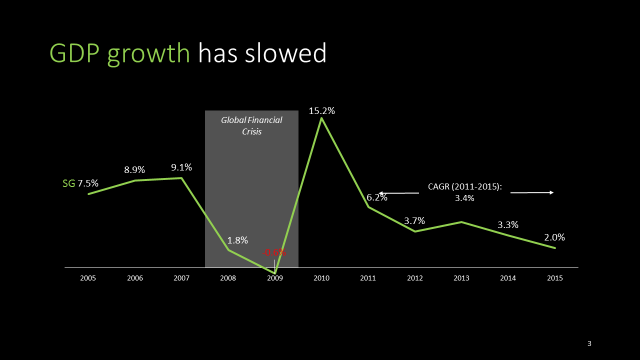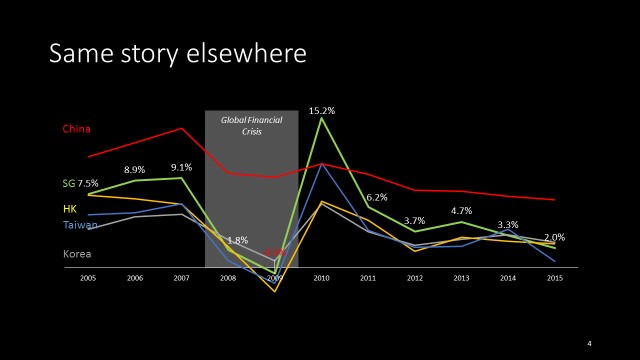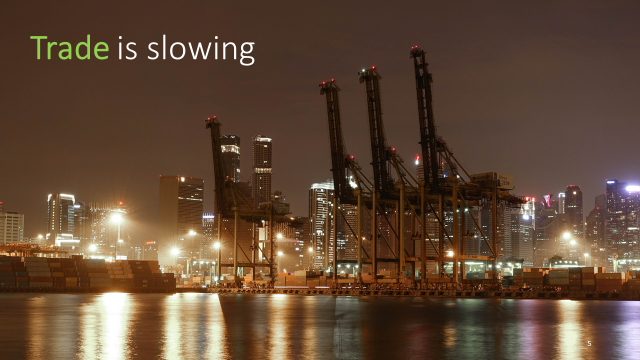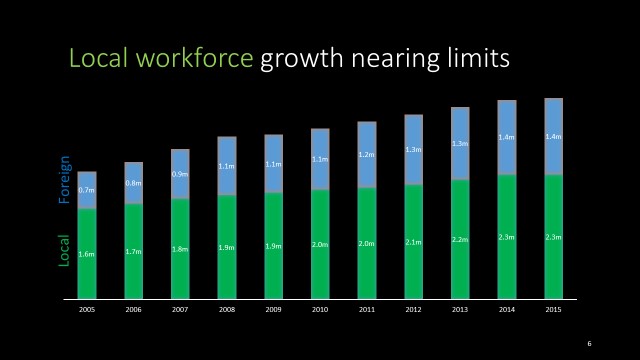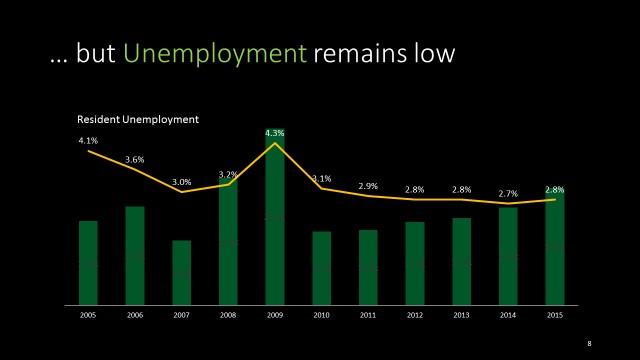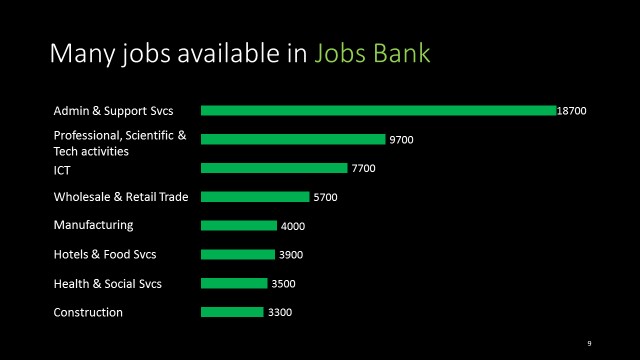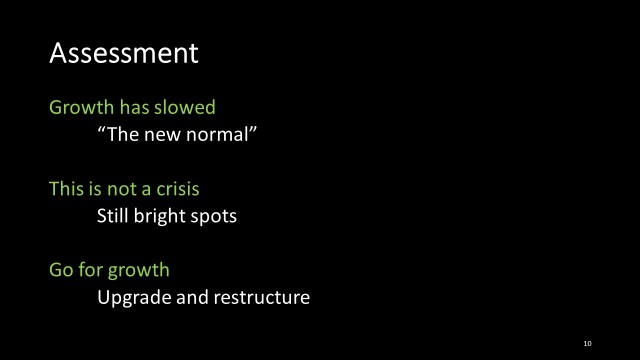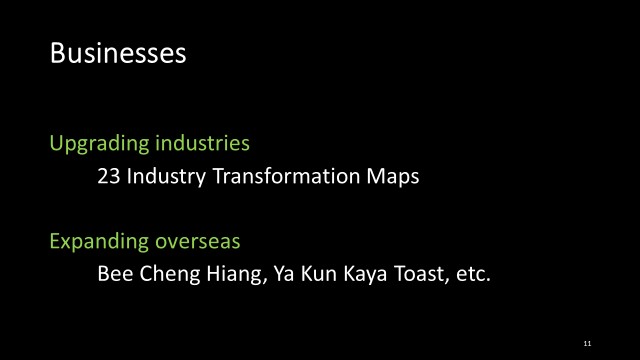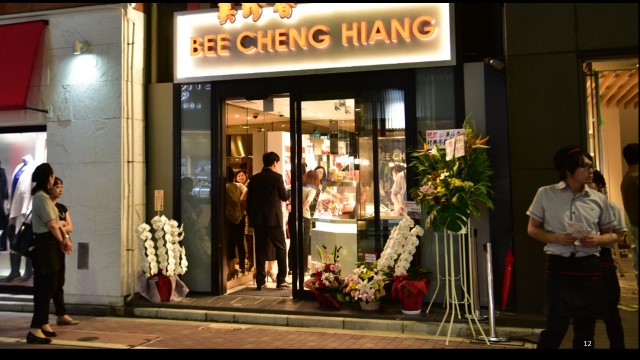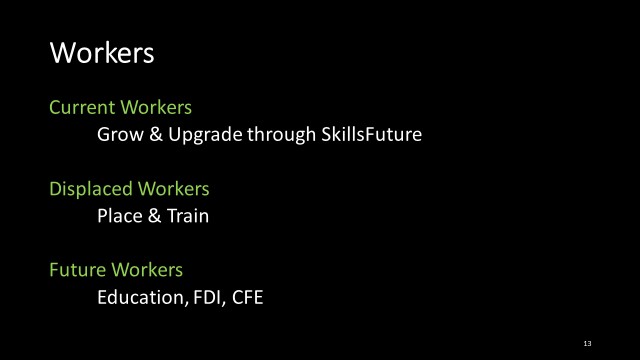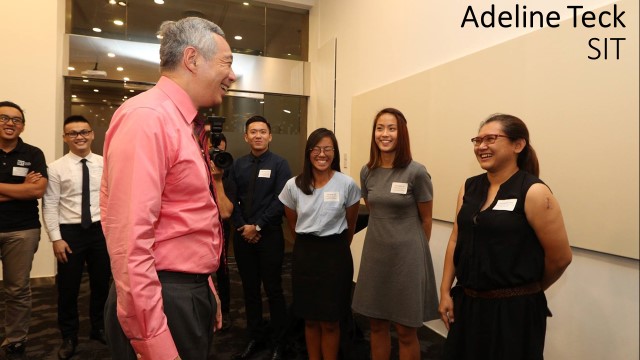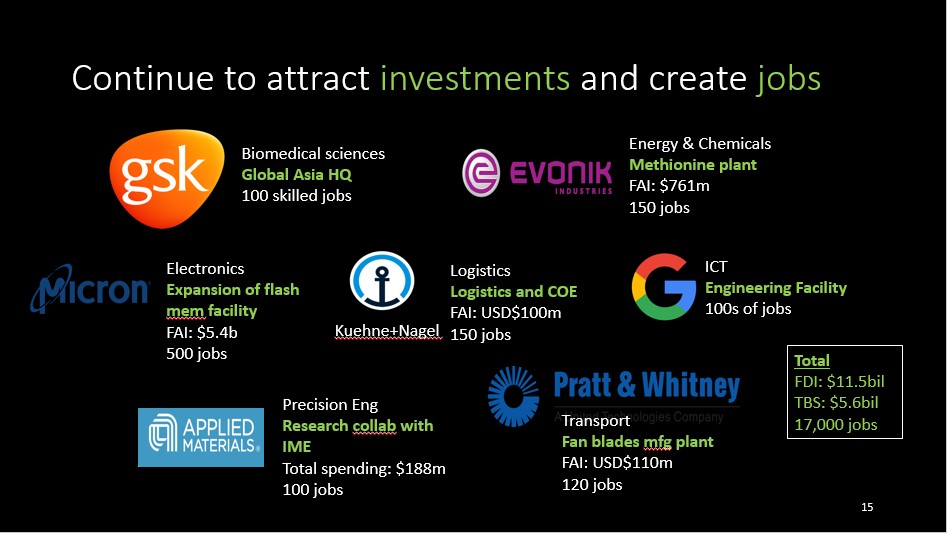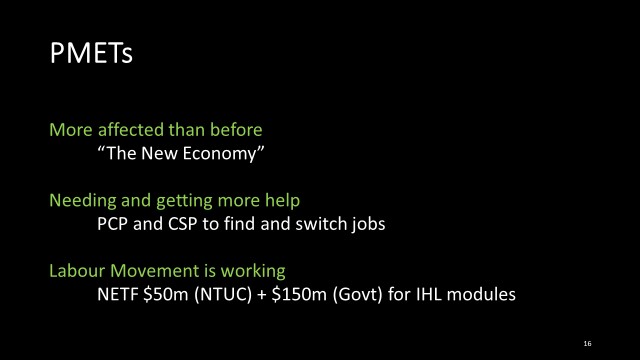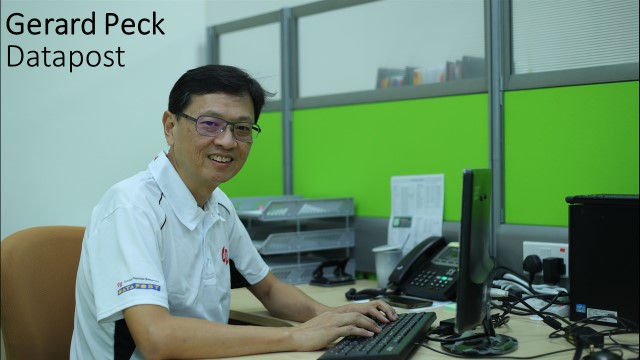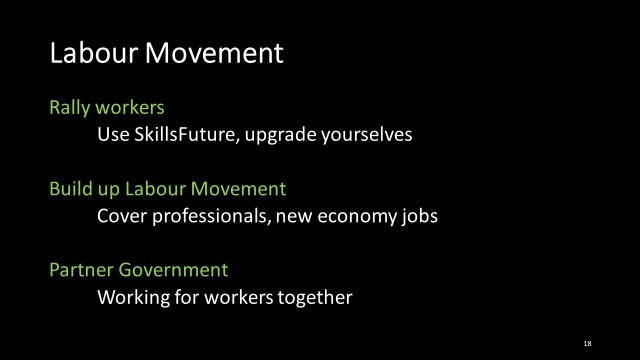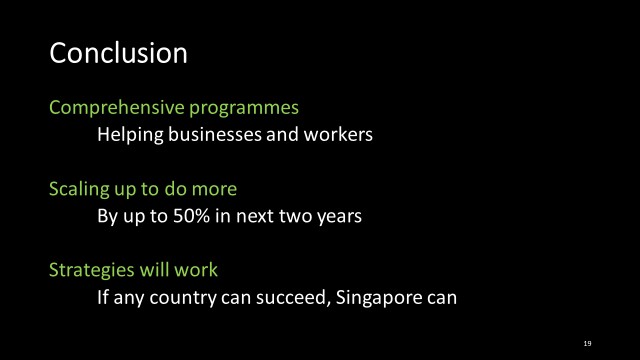PM Lee Hsien Loong at the Dialogue with Labour Movement Leaders on 1 November 2016.
Sister Mary Liew, President of the NTUC, Brother Chan Chun Sing, Secretary-General, and brothers and sisters. Thank Brother Chun Sing for invitation.
The economy has been in the news quite a bit recently, that it is slowing down and businesses are feeling the strain. Workers are also getting anxious about the job market. Brother Chun Sing tells me that this is the top concern among labour movement leaders and members. So I thought that I should meet you to talk about the economy.
I will give you my view of where we are today, talk about what we are doing together and discuss what the labour movement can do. First, let me show you a few charts to frame our discussion. This is our gross domestic product (GDP) growth rate over the past 10 years.
Before the Global Financial Crisis, we were growing at about eight per cent. Then in 2008, the crisis hit. We rebounded strongly quickly after. Last year, we grew two per cent. This year, we are at lower end of one per cent to two percent.
The story is similar for other countries.
It points to structural changes in all economies. Trade is down, oil price is down.
If you look at workforce, our local workforce has been growing. It is boosted by women and seniors joining the workforce.
But we are nearing our limits, as seen from the 2014/15 numbers. Furthermore, we are ageing. Baby boomers are beginning to retire. We have fewer babies, so there are fewer young Singaporeans joining the workforce than the Singaporeans retiring. Our local workforce is levelling off, heading for negligible or even stagnant growth in the next decade.
We have also tightened up on the number and quality of foreign workers. Annual growth has slowed from 80,000 a few years ago to 25,000 in the past two years. Putting them together, our total workforce will grow much slower from now on. We need to grow through productivity rather than labour force growth.
Our number of redundancies has been gradually going up.
But the situation is not dire as our resident unemployment rate is still low.
The Labour Market advance estimates for the third quarter in 2016 show that resident unemployment rate has remained low, broadly unchanged from June 2016 at around three percent. And fewer workers have been laid off in this quarter than the last, at 4,100 as compared to 4,800 workers.
We are still creating jobs and jobs are still available. For example, you can find jobs online at the Job Bank.
What do we conclude from all this? There are three points.
Firstly, economic growth has slowed down. Partly the new normal, because we are now a more developed economy. Partly difficult external conditions.
Economic growth has slowed down. Partly the new norma ... partly difficult external conditions. PM Lee Hsien Loong![]()
Trade is slow. Our port workers know this. Earlier this year, Sister Jessie Yeo shared with me how there were several shifts in a day where there were no ships coming in to Pasir Panjang. Since then, container volume has picked up, but it is still lower than 2014 peak of three million twenty-foot equivalent unit (TEU) per month.
The oil price is down. Households benefit from lower electricity and gas prices, cheaper public transport and cheaper petrol. But some industries are affected, such as the oil and gas and the offshore and marine industries. There are some jobs lost. Mostly foreign workers, but some Singaporeans too. Other economies are seeing the same trend.
But, secondly, we are not in a crisis. Growth is still positive. Global demand is down in several industries. But when demand recovers, we can aim for two per cent to three per cent growth on average. It is still faster than developed countries in the same position. There are bright spots. For example, in the information and communications technology (ICT,) education, health and social services sectors, we are attracting substantial investments and creating many new jobs.
Thirdly, what we need now is not an emergency package, but a consistent longer-term strategy to go for growth. The Global Financial Crisis was a full-blown, global crisis. Singapore too fell sick and had to quickly take antibiotics. We did a big package which includes reduced business costs and protected jobs. Fortunately, the global crisis receded in Singapore. Our medicine worked and we recovered quickly.
This time it is different. It is not a crisis, but a structural problem. It is not an infection that can be cured with one course of antibiotics. But this is something that we have to work at over the long term, taking vitamins every day, following a rigorous exercise and training programme. Gradually, we will strengthen ourselves and build new capabilities. To continue growing and creating good jobs, we have to upgrade and restructure.
What do we have to do to restructure our economy and upgrade ourselves? In fact, we are already doing many things. The broad strategy is in place. Tonight, I want to pull all the pieces together and paint in broad strokes the full picture. To show you how everything fits together and what more we need to do over the coming months and years. All of us have a part to play.
The tripartite partnership is a cornerstone of our economy. I will speak about how the Government is working with businesses, our strategy to help workers, especially professionals, managers, executives and technicians (PMETs), and the labour movement’s role in this national effort.
We are helping businesses in two ways.
Firstly, we want to transform industries and our small and medium-sized enterprises (SMEs). We are doing it industry by industry with the Industry Transformation Programme which was announced in Budget 2016. Every industry faces its own set of challenges. Together with labour movement and businesses, we are developing 23 individual Industry Transformation Maps (ITMs), which together cover 80 per cent of our economy. ITMs will transform not just entire industries, but also help individual SMEs.
Three ITMs are already in place. They are precision engineering, food services, and retail. Take precision engineering. We aim to get the whole industry to adopt digital manufacturing techniques so that we can customise solutions, open up new markets, and compete internationally. Precision engineering used to rely on highly skilled craftsmen, making moulds, using hands and operating machine tools. Now, with digital manufacturing, you still need precision, but it comes from computer controlled machines. You still need skills, but new skills. Now it is about programming, setting up machines and maintaining machines.
It is a whole of Singapore effort. Economic Development Board (EDB) is helping to set up multi-company collaborations and helping businesses to link up with technology partners overseas, like in Germany. The trade association, Singapore Precision Engineering and Technology Association (SPETA), is helping members to adopt and implement the new technology. SkillsFuture Singapore and Workforce Singapore are developing skills roadmaps and training programmes in consultation with the businesses and labour movement.
A big thank you to all the Labour Movement leaders who have contributed to the ITMs. For those who worked on the three ITMs that have already been launched, please continue to work together to implement them. For those involved in the 20 ITMs still in the works, I hope you will work closely with tripartite partners and share your unique perspective.
Secondly, we are helping businesses to find opportunities overseas. We can do a lot to help companies strengthen their core business but our small domestic market will always be a challenge. So when I go overseas, I often bring along business missions and open doors for Singapore companies. We have had some success helping our food brands expand overseas.
When I was in Tokyo a few weeks ago, Bee Cheng Hiang had just opened a shop in the Ginza district at Tokyo. It is very popular! But actually it took years of effort because Japan has strict regulations on importing food. International Enterprise (IE) Singapore and Agri-Food & Veterinary Authority of Singapore (AVA) helped Bee Cheng Hiang to get the import permits and also helped in its retail marketing efforts. This opened the way for other food brands to enter Japan.
With the support of IE Singapore, our food companies have expanded all over Asia. Wee Nam Kee Chicken Rice in Manila, Ya Kun Kaya Toast in Jakarta, Mr Bean in Shibuya, Tokyo, ,Tai Sei Hei (Lao Ban Tau Hway) in Ho Chi Minh, Janice Wong Desserts in Hong Kong and Tong Garden (Nuts) in Gujarat, India.
These are home-grown SMEs that have gone global, tapping the growing consumer market in our region and also on our Singapore Brand of safety, quality, and of course our love for good food!
We support these businesses because they can create good jobs for Singaporeans. But as we upgrade our businesses, the sort of jobs that they offer will be different. So we are also supporting our workers to gain skills to do these jobs.
I will speak about three groups of workers.
The current workers, displaced workers and future workers. For current workers, SkillsFuture will help you upgrade. We are offering more courses. There are many mature students who are upgrading, like Adeline whom I met at SIT last week. Adeline has been working as an Occupational Therapist for 20 years.
We have programmes like the TechSkills Accelerator (TeSA) to train you in areas where there are jobs and growth prospects. We also subsidise your training and course fees, and provide study awards. 52,000 Singaporeans above 40 years old have already benefitted from the higher subsidies from SkillsFuture.
We have given out 490 SkillsFuture Study awards to workers like Mdm Janessa, whom I spoke about at the NDR, who is upgrading to fulfil her ambition to become a Preschool Centre Principal. By 2020, we will be spending more than $1billion per year on SkillsFuture and related initiatives
Secondly, we are helping displaced workers who have lost their jobs to find new jobs. Technology and markets are moving fast and Singapore cannot fight this change. We have to let old jobs go and get into new jobs. But we can and must help the people who are affected. What are we doing? There are three aspects.
One, if you are facing retrenchment, NTUC and Ministry of Manpower (MOM) will make sure you are treated fairly.
Two, we match-make displaced workers with available jobs. There is the Jobs Bank where you can apply for jobs online. There are more than 63,000 jobs available! This includes vacancies for software developers, business consultants, registered nurses and more. Or you can go to job fairs and career centres for advice and support. We even have virtual job fairs now. There is one currently on by e2i for the ICT sector. And we do not just place, we also train you if you need to switch to a different field. Last year, Workforce Development Agency (WDA) and e2i placed 17,000 individuals. This year, Workforce Singapore (WSG) has already placed 13,000 individuals for which 45 per cent are PMETs and 55 per cent are Rank-and-file. They are ready to place more next year.
Three, we help you financially to make the transition. We work with employers to help pay the training fees and provide wage offsets so your income remains stable as you transition. We have strengthened our safety nets so families do not have to worry. For healthcare, we have MediShield Life, Pioneer Generation Package for your parents and Community Health Assist Scheme. There are education bursaries for your children. For your daily expenses, there are GST vouchers and U-Save.
Thirdly, for our future workers, we are giving them a good education and preparing them for the job market. We are giving them future-ready and workplace-ready skills. Our SkillsFuture Earn and Learn Programme (ELP) gives Institute of Technical Education (ITE) and polytechnic students actual work experience early on, and earn a qualification, like a diploma, at the same time. You can look forward to more than 20 new ELPs in different sectors by the end of this year.
Our new universities like SIT and UniSim don’t just give you a degree. They emphasise on applied pathways which leads to industry-relevant qualifications. Most importantly however, is to grow the economy and create new jobs. We must continue to upgrade and restructure our economy.
We have been working hard to attract new investments into Singapore. I will share with you a few examples of the investments Economic Development Board (EDB) has brought in.
This includes Glaxosmithkline, Micron, Evonik, Pratt and Whitney, Kuehne + Nagel, Applied Materials and Google.
Last year, EDB attracted $11.5billion of total of foreign direct investment and $5.6billion of total business spending last year which will eventually create 17,000 jobs. The Committee on the Future Economy (CFE) under Minister Heng Swee Keat and Minister S Iswaran, is planning ahead for the next 10-15 years. CFE is developing strategies to take advantage of our strengths and grow our economy. This helps make sure that when future workers come into the workplace, there will be opportunities for them. Minister Iswaran can tell you more about this later
One group we are paying special attention to are PMETs.
PMETs now make up more than half of the workforce. In recent retrenchments, more PMETs are being affected. The solution for PMETs is the same, which is to retrain and find new jobs. But often, it is more difficult to do. This is because PMET skills are more company-specific. For example, if you a bank manager, your branch operates in a certain way. But other companies have different processes. Thus, more personalised attention is needed to retrain PMETs and match them to new jobs. We are doing more to help PMETs cope.
Our Professional Conversion Programmes and Career Support Programmes (CSP) are two examples which help our PMETs move into growing industries. These programmes provides wage subsidies so mature PMETs can move to new companies without taking a deep pay cut. Our Labour Movement is also playing its part.
NTUC is raising $50million for the NTUC Education and Training Fund (NETF), which the Government will match with a three is to one ratio, with an additional grant of up to $150million. NTUC is also working with our institute of higher learnings, Nanyang Technological University and National University of Singapore, to develop relevant modules for working adults. We are also exploring cooperation with the Polytechnics and ITEs
One example is Gerard Peck whom I mentioned during NDR.
Gerard was in information technology (IT) and he left the bank after 30 years. He signed up for CSP and with e2i’s help, landed job as Head of IT at Datapost.
I have painted you a picture of where we are and what we are doing together. We have a good chance to transform ourselves and succeed. One reason is because our Labour Movement plays a very active role in restructuring. Your support, as Labour Movement leaders, is the secret to our success
As Singapore has developed, at each stage, labour movement leaders have rallied workers to accept and adapt to change. BEST/WISE programme, computer literacy and productivity. Please continue to encourage your workers to use SkillsFuture to upgrade yourselves
You have also built up the Labour Movement, fought for a fair deal for workers and partnered businesses to find win-win solutions. You are now also extending your coverage to PMETs. You are forward-looking and always preparing ahead for the next challenge.
I am glad that NTUC will be setting up a new unit, The Future Jobs, Skills, and Training Department, led by Brother Patrick Tay, to work with businesses and Government, to identify trends, start job matching services and training programmes. That is why we must always have good people in our labour movement, and close rapport and trust between our labour movement and Government.
When you asked me to send you Brother Chan Chun Sing, I was happy to do so. Brother Chun Sing has discussed with me his plans to increase the flow of talent between the labour movement and the Government. This would enable both sides to understand each other better, help the Government appreciate the problems that you face and make policies which respond to these needs.
I hope you will embrace the civil servants who come over to serve in the labour movement, help to educate them, and make them your friends and champions even after their union stints. Therefore, I ask for your help to rally our workers.
We have a comprehensive strategy in place which we will be systematically implementing it to help all sectors of the economy, the businesses and the workers. We are scaling up these programmes and schemes to do more. We will increase funding up to 50 per cent for some programmes in the next two years
Our strategies will work. If any country can succeed, Singapore can. Because we have the resources, we have the wherewithal and we work together.
Thank you.
Explore recent content
Explore related topics

